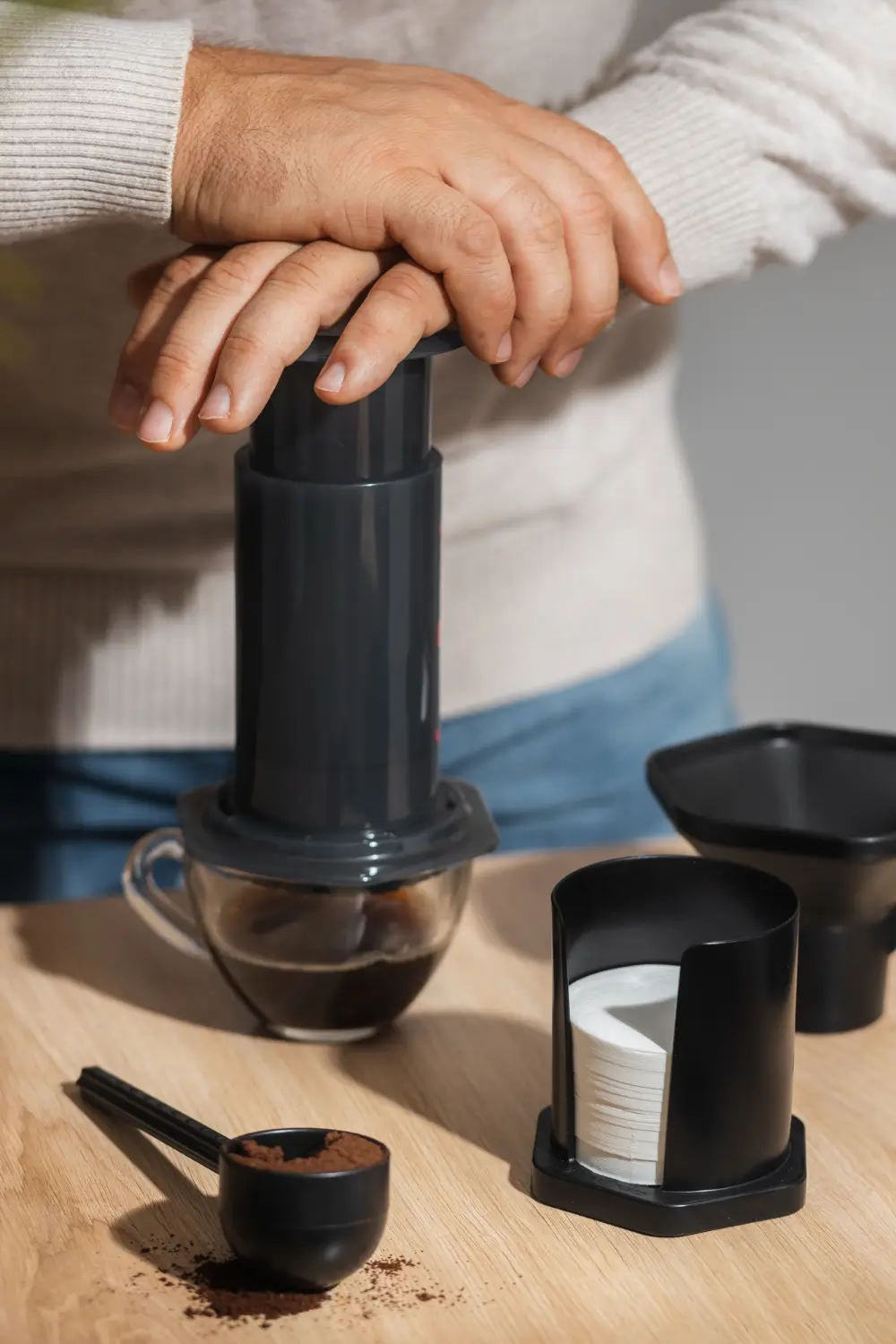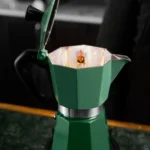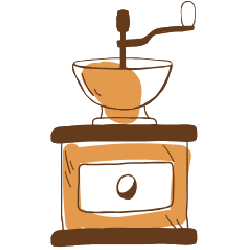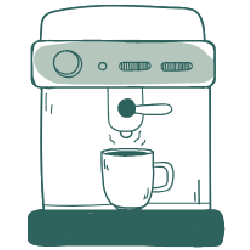What is AeroPress Coffee?
The AeroPress is a manual coffee maker. It quickly makes smooth, grit-free coffee. It has two main parts: a chamber and a plunger. The plunger fits tight inside the chamber. This creates an airtight seal.
- What is AeroPress Coffee?
- How does the AeroPress work?
- What are the key features of the AeroPress?
- How to brew coffee with an AeroPress?
- How do you prepare the AeroPress and filter for brewing?
- How do you weigh and grind coffee for AeroPress?
- How do you set up your AeroPress (standard vs. inverted)?
- How do you add coffee grounds to the AeroPress?
- How do you add water and saturate grounds for AeroPress bloom?
- How do you fill the AeroPress chamber with remaining water?
- How do you stir coffee in the AeroPress?
- How do you attach the filter cap and steep AeroPress coffee?
- How do you flip and plunge the AeroPress?
- How do you serve and enjoy AeroPress coffee?
- What does AeroPress coffee taste like?
- How does AeroPress compare to other coffee makers like French press and pour-over?
- How can you optimize your AeroPress brew?
- How do you adjust the coffee-to-water ratio for AeroPress?
- How do you optimize grind size for AeroPress?
- How do you perfect your AeroPress stirring technique?
- Should you consider double filters for a cleaner AeroPress cup?
- How do you tailor AeroPress parameters to your beans and taste?
- What are the advantages and disadvantages of the AeroPress?
- What are the key advantages of the AeroPress?
- What are the potential disadvantages of the AeroPress?
It works like a piston. Pressure pushes water through the coffee. AeroPress, Inc. makes this device. Coffee fans and travelers love it. Its simple design makes a clean cup. You won’t find sediment in your coffee. The AeroPress coffee maker offers an easy brewing experience.
How does the AeroPress work?
The AeroPress uses a rapid immersion process. This sets it apart from other manual brewers. Hot water quickly steeps the coffee grounds. This starts the extraction. After a short steep, the plunger gently pushes air. This forces water through a paper microfilter.
It doesn’t make high-pressure espresso. But the air pressure helps extract more flavor. You get a bold, full-bodied coffee. Drink it as a concentrated shot. Or dilute it for an American-style coffee. This whole process stops over-extraction. You avoid bitterness. The result is a remarkably clean cup.
What are the key features of the AeroPress?
The AeroPress has several key features. They make it popular and widely used. Its design focuses on efficiency, versatility, and ease of use. These traits make it a favorite for home and travel.
- Rapid brewing time: The AeroPress coffee maker brews a delicious cup in about 1 to 2 minutes. This speed works well for busy mornings.
- Paper microfilters: It uses small paper microfilters to prevent gritty coffee. These filters trap sediment and oils, making a cleaner, smoother brew.
- Versatile capacity: The device makes 1 to 3 cups of coffee concentrate per press. You dilute this concentrate to your desired strength and volume.
- Espresso-style coffee: The gentle pressure lets you brew espresso-style coffee. This concentrated brew makes a great base for lattes, cappuccinos, and other milk-based drinks.
- Simple components: The AeroPress has few basic parts. These include the main chamber, a plunger, a filter cap, a coffee scoop, and a stirring stick. This ensures easy assembly and disassembly.
- Safe and durable material: It is made from BPA- and phthalate-free plastic. This makes it safe for food and very durable. Its strong build suits adventurous travel and daily use.
- Multiple brewing methods: It supports various brewing techniques. These include the Standard Brewing Method and the Inverted Brewing Method. This versatility lets you try different flavor profiles and extraction rates.
How to brew coffee with an AeroPress?
Brewing coffee with an AeroPress coffee maker is simple. You can customize it to your taste. Mastering the AeroPress brewing process means paying attention to grind size, water temperature, and brew time. These elements all change your coffee’s final flavor and strength.
For best results, aim for consistency. The AeroPress is versatile, so many recipes exist. But this guide covers the core steps. Precision in preparation gives you a clean, flavorful, and satisfying cup every time.
How do you prepare the AeroPress and filter for brewing?
Preparing the AeroPress and its filter is the first crucial step. Make sure your AeroPress parts are clean and dry. Or you can rinse and warm them with hot water. Then, put one of the small AeroPress paper filters into the filter cap.
Rinse this filter with hot water. This removes any papery taste and preheats the cap. Finally, attach the filter cap tight to the brew chamber. Skip this if you plan to use the inverted brewing method. This preparation ensures a clean taste and proper temperature for extraction.
How do you weigh and grind coffee for AeroPress?
Weighing and grinding your coffee beans accurately improves your AeroPress brew. Measure about 15–18 grams of whole coffee beans. This amount can change based on your desired strength and recipe. Then, use a good coffee grinder. Aim for the ideal consistency.
The recommended grind for AeroPress is medium-fine to fine. Think of table sugar or fine salt. A consistent grind is important for even extraction. It stops your coffee from being under- or over-extracted. Achieving this precise grind ensures optimal flavor extraction during brewing.
How do you set up your AeroPress (standard vs. inverted)?
You can set up your AeroPress in two ways: standard or inverted. For the Standard Brewing Method, put the brew chamber directly onto your mug. The flared end faces up. This setup lets coffee drip right into your mug as it brews.
The Inverted Brewing Method means you insert the plunger a few centimeters into the brew chamber. Then you set the whole device upside down. This stops dripping. It lets coffee steep longer before you flip it to plunge. Each method changes the brewing process slightly and impacts taste.
How do you add coffee grounds to the AeroPress?
Adding ground coffee is a simple step. Carefully put your fresh ground coffee beans into the main AeroPress chamber. Make sure all the grounds settle at the bottom. This prepares them for water.
How do you add water and saturate grounds for AeroPress bloom?
Adding water to saturate the grounds is called the bloom. This is important for great AeroPress extraction. Start your timer right after you pour hot water over the grounds. The best water temperature is typically 200–205°F (93–96°C). You can reach this with a good kettle.
Pour just enough water to wet all the coffee grounds. This is usually about twice the coffee weight—for example, 30 grams of water for 15 grams of coffee. Let the coffee bloom for 30 seconds to 1 minute. This lets gases escape. It prepares the grounds for even extraction. This step improves flavor in your final cup.
How do you fill the AeroPress chamber with remaining water?
After blooming, fill the AeroPress chamber with the rest of the hot water. This completes the brewing volume. Add hot water until you reach your desired total water weight. Or fill it to the marked level on the chamber. For instance, if you used 15 grams of coffee, you might add water to reach a total of 210–250 grams.
How do you stir coffee in the AeroPress?
Stirring the coffee in the AeroPress ensures even saturation. It also creates consistent coffee brewing extraction. After adding all the water, gently stir the coffee. Use the provided stick or a spoon. Stir about 10 times. Use a back-and-forth motion, not circular stirs.
This technique stops channeling. Channeling is when water flows unevenly through the coffee. This leads to under-extracted areas. Proper stirring means water touches all coffee particles. This makes a more balanced and flavorful brew. Even extraction means a superior cup.
How do you attach the filter cap and steep AeroPress coffee?
After stirring the coffee grounds, attach the filter cap tight to the AeroPress chamber. Do this if you use the standard method. For both standard and inverted methods, this step seals the brew. It prepares it for steeping. Let the coffee steep for your recommended total brew time. This is typically 1 to 2 minutes.
How do you flip and plunge the AeroPress?
If you used the inverted method, carefully flip the AeroPress over onto your mug. Hold both pieces firmly. For both brewing methods, place the AeroPress over your mug. Then, press down the plunger. Apply slow, steady, and even pressure. Press until all liquid goes through the filter. You will hear a distinct “hissing sound.”
This hiss means most coffee is out of the grounds. A controlled plunge keeps the coffee bed stable. This leads to a smooth extraction. The plunging motion is key to the AeroPress brewing process.
How do you serve and enjoy AeroPress coffee?
Once plunging finishes, remove the AeroPress from your mug. You can easily eject the compressed puck of used grounds and filter. Put it into a compost bin or trash. Your fresh brewed coffee is ready. Enjoy its clean and flavorful experience.
What does AeroPress coffee taste like?
AeroPress brewed coffee has a bright, clean, and volatile flavor. It often highlights fruity and floral notes with brisk acidity. This gives it a lively, sharp taste. The paper microfilter removes most oils and sediment. This creates an exceptionally clean and smooth mouthfeel.
When brewed well—with the right grind and water temperature—AeroPress coffee has low bitterness. It avoids unpleasant acidity. It usually has more body than drip coffee. But it is lighter than a French press brew. A key feature: it keeps brisk, nuanced flavors as it cools. It does not become flat or muddy.
The flavor of AeroPress brewed coffee is also very adjustable. You can tweak grind size, water temperature, and brew time. This lets you emphasize acidity, body, or clarity as you prefer.
How does AeroPress compare to other coffee makers like French press and pour-over?
The AeroPress differs from other popular coffee makers. Think of the French Press and Pour-Over Coffee Maker. It stands out in flavor clarity, body, and convenience. AeroPress coffee is often cleaner and brighter. It has a lighter body. Its paper filter traps oils and fine particles. This reduces bitterness and improves clarity. A French Press uses a metal mesh filter. This lets more oils and sediment into the cup. It makes a full-bodied, heavier mouthfeel. It also creates a richer, but sometimes “cloudy,” flavor.
Pour-Over Coffee Makers, like Chemex or V60, also make a clean, clear cup. They generally bring out lighter, floral, or fruity notes. This is especially true with lighter roasts. Pour-over needs precise pouring technique and water flow control. The AeroPress gives you more physical control over brewing time. Its plunger design reduces variability. The AeroPress is also more portable and quicker to brew than a French Press. This makes it better for single servings or travel. It is much easier and faster to clean. This offers great convenience for daily use.
| Feature | AeroPress | French Press | Pour-Over |
|---|---|---|---|
| Filter type | Paper microfilter | Metal mesh filter | Paper filter |
| Clarity/Sediment | Very clean, sediment-free | More sediment, cloudy | Clean, clear |
| Body | Medium, lighter than French Press | Full-bodied, heavy | Light, delicate |
| Portability | Very high (compact, durable) | Medium (glass can break) | Medium (requires careful setup) |
| Brew time | Fast (1–2 minutes) | Moderate (4+ minutes) | Moderate (3–5 minutes) |
| Ease of cleaning | Very easy, quick rinse | Moderate, grounds can stick | Easy, dispose of filter |
| Brewing control | High (plunge pressure, immersion) | Moderate (immersion time) | High (pour technique, flow) |
| Flavor profile | Bright, clean, highlights nuances | Rich, bold, full flavor | Highlights delicate notes, fruity/floral |
| Best for | Versatile, quick, travel, concentrate | Rich, full-bodied, traditional brew | Clean, nuanced, lighter roasts |
Overall, the AeroPress offers a balanced choice. It is cleaner than a French press. But it is also more flexible and portable. It can make both lighter and heavier brews. It appeals to those who want convenience and experimental brewing. The French Press is still great for straightforward, rich, full-bodied coffee. The Pour-Over Coffee Maker excels at clarity and nuanced lighter flavors. But it needs careful technique.
How can you optimize your AeroPress brew?
Optimizing your AeroPress brew lets you fine-tune the extraction. You can get a cup perfectly suited to your taste. This means adjusting several key things. Trying different variables will greatly improve your AeroPress experience. You can unlock the full flavor potential of your coffee beans.
How do you adjust the coffee-to-water ratio for AeroPress?
Adjusting the coffee-to-water ratio changes your AeroPress brew’s strength and richness. For a very strong, espresso-like concentrate, try a ratio around 1:6. For example, 15 grams of coffee to 90 ml of water. For a more balanced, everyday cup, a ratio of about 1:15 is common. That’s 14–18g coffee to 200–220ml water.
If you like a lighter, smoother brew, use less coffee. Try 12–14g per 200ml of water. More coffee means stronger, richer flavors. Less coffee makes a milder cup. Try different ratios to find your ideal coffee strength.
How do you optimize grind size for AeroPress?
Optimizing grind size controls extraction speed and intensity for your AeroPress coffee. The AeroPress usually works best with a medium-fine to fine grind. Think of table salt. Finer grinds make a stronger brew. They also speed up extraction. This suits shorter brew times.
Coarser grinds work better for longer immersion times. They make a lighter, more delicate cup. Start with a medium-fine grind. Then adjust it based on your taste. A consistent grind from your coffee grinder is important. It prevents uneven extraction and ensures balanced flavor.
How do you perfect your AeroPress stirring technique?
Perfecting your stirring ensures even wetting of coffee grounds. It prevents uneven extraction or channeling in your AeroPress. Don’t use circular motions. Gently stir the coffee grounds back and forth. Use the paddle or a spoon. This method helps water evenly saturate all coffee particles.
Proper agitation stops a “dome” from forming in the coffee bed. This dome can cause water to bypass some grounds. This leads to under-extraction. Consistent and uniform extraction from correct stirring unlocks your brew’s full flavor. This small adjustment makes a big difference.
Should you consider double filters for a cleaner AeroPress cup?
Yes, you can use double filters for an even cleaner AeroPress cup. Using two AeroPress paper filters instead of one can further reduce sediment. This also helps stop any dripping while the coffee steeps.
You get an even cleaner, brighter, and more polished cup. Clarity improves. A single filter works well. But doubling up gives an extra layer of filtration. This is for those who want the cleanest possible brew. It is a simple change that can improve your coffee experience.
How do you tailor AeroPress parameters to your beans and taste?
Tailoring AeroPress parameters to your specific coffee beans and taste is key. It helps you get the most out of its versatility. The AeroPress allows much experimentation. Try different brew times, hot water temperatures, and agitation.
Different coffee beans—especially those with unique flavors—respond differently. Lighter roasts might need slightly higher water temperatures or longer bloom times. This helps extract their delicate notes. Darker roasts might need cooler water or shorter immersion times. This helps avoid bitterness. Keep trying different settings. This helps you find the best extraction for each coffee type. You can achieve your preferred flavor.
What are the advantages and disadvantages of the AeroPress?
The AeroPress has advantages and disadvantages. Knowing these helps you decide. Is this device right for your coffee habits? It offers a unique mix of convenience and quality.
What are the key advantages of the AeroPress?
The AeroPress has many benefits. They make it a popular choice for coffee enthusiasts. Its design focuses on efficiency, portability, and ease of use. These advantages contribute to its wide appeal.
- Quick brewing time: It brews coffee very fast, usually in 1 to 2 minutes. This makes it great for quick coffee, especially during busy times.
- Simple and easy to use: The design and brewing process are very intuitive. Even new users can quickly master the AeroPress. This ensures consistent results.
- Easy and fast to clean: Cleaning the AeroPress is very simple and quick. Its parts rinse easily under running water. This is handy for daily use and brewing on the go.
- Portable and compact: The device is light, small, and made of durable plastic. This makes it great for travel, camping, or the office. It fits easily into bags.
- Produces a clean, smooth cup: The paper microfilter effectively traps sediment and bad oils. This results in coffee that is very clean, smooth, and free from grit or bitterness.
- Highly versatile: The AeroPress can brew various strengths and styles of coffee. It makes everything from a concentrated espresso-like shot to a full-bodied American-style brew.
- Affordable: Compared to many other good coffee makers, the AeroPress costs less. This makes it an accessible choice for many coffee lovers.
What are the potential disadvantages of the AeroPress?
The AeroPress has many benefits. But it also has limits. Future users should think about these. These points can affect if it suits your brewing needs. Understanding these gives a balanced view of the device.
- Limited brewing capacity: The AeroPress usually makes only 1 to 2 cups of coffee at a time. This small volume makes it less ideal for serving larger groups quickly. It also isn’t great for brewing many cups at once.
- Paper filter dependency: It needs small, disposable paper filters for its signature clean cup. These filters cost money over time and create waste. But reusable metal filters are available as an alternative.
- Not always ideal for lighter roasts: Some users find the AeroPress does not bring out delicate notes in lighter roast coffees as well as some other methods. Pour-overs, for example, might do better.
- Plunger maintenance: Cleaning is generally easy. But the rubber plunger can stain over time from coffee oils. This might need more thorough attention and occasional deep cleaning to keep it in good shape.
- Plastic body concerns: It is made mostly of plastic parts. These are BPA- and phthalate-free. But some users might prefer glass or stainless steel for environmental or aesthetic reasons.
The AeroPress is a versatile, efficient, and user-friendly coffee maker. It consistently delivers a unique and clean flavor. Its design balances convenience with quality. This makes it a beloved tool for coffee fans worldwide. It simplifies the brewing process. Yet it offers much control over the final taste.
Want a quick, strong shot to start your day? Or a smooth, clean cup for leisurely enjoyment? The AeroPress can adapt. Its portability, easy cleaning, and affordability add to its appeal. It works as a daily brewer or a travel companion. Try the AeroPress and experiment with recipes. You might discover your perfect cup.









